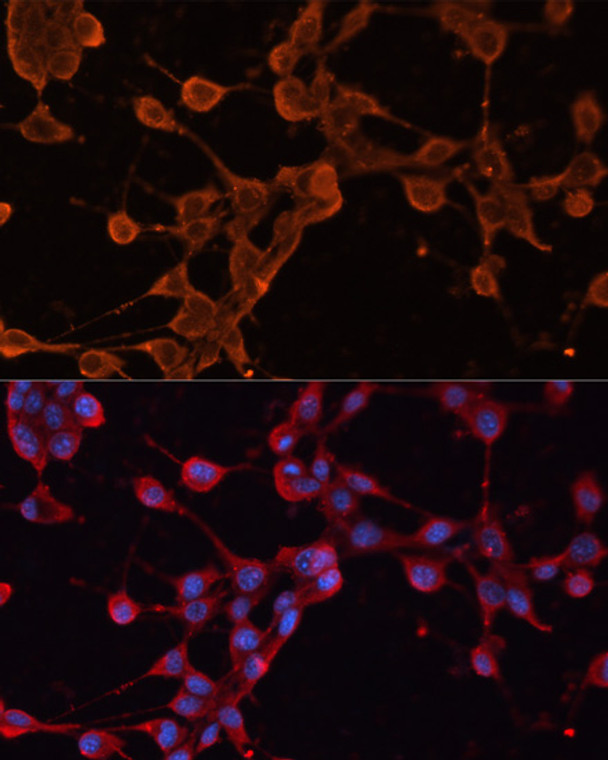| Host: |
Rabbit |
| Applications: |
IF |
| Reactivity: |
Mouse/Rat |
| Note: |
STRICTLY FOR FURTHER SCIENTIFIC RESEARCH USE ONLY (RUO). MUST NOT TO BE USED IN DIAGNOSTIC OR THERAPEUTIC APPLICATIONS. |
| Short Description: |
Rabbit polyclonal antibody anti-ABCB11 (1050-1150) is suitable for use in Immunofluorescence research applications. |
| Clonality: |
Polyclonal |
| Conjugation: |
Unconjugated |
| Isotype: |
IgG |
| Formulation: |
PBS with 0.01% Thimerosal, 50% Glycerol, pH7.3. |
| Purification: |
Affinity purification |
| Dilution Range: |
IF/ICC 1:50-1:200 |
| Storage Instruction: |
Store at-20°C for up to 1 year from the date of receipt, and avoid repeat freeze-thaw cycles. |
| Gene Symbol: |
ABCB11 |
| Gene ID: |
8647 |
| Uniprot ID: |
ABCBB_HUMAN |
| Immunogen Region: |
1050-1150 |
| Immunogen: |
A synthetic peptide corresponding to a sequence within amino acids 1050-1150 of human ABCB11 (NP_003733.2). |
| Immunogen Sequence: |
RFFQLLDRQPPISVYNTAGE KWDNFQGKIDFVDCKFTYPS RPDSQVLNGLSVSISPGQTL AFVGSSGCGKSTSIQLLERF YDPDQGKVMIDGHDSKKVNV Q |
| Tissue Specificity | Expressed predominantly, if not exclusively in the liver, where it was further localized to the canalicular microvilli and to subcanalicular vesicles of the hepatocytes by in situ. |
| Post Translational Modifications | N-glycosylated. Ubiquitinated.short-chain ubiquitination regulates cell-Surface expression of ABCB11. |
| Function | Catalyzes the transport of the major hydrophobic bile salts, such as taurine and glycine-conjugated cholic acid across the canalicular membrane of hepatocytes in an ATP-dependent manner, therefore participates in hepatic bile acid homeostasis and consequently to lipid homeostasis through regulation of biliary lipid secretion in a bile salts dependent manner. Transports taurine-conjugated bile salts more rapidly than glycine-conjugated bile salts. Also transports non-bile acid compounds, such as pravastatin and fexofenadine in an ATP-dependent manner and may be involved in their biliary excretion. |
| Protein Name | Bile Salt Export PumpAtp-Binding Cassette Sub-Family B Member 11 |
| Database Links | Reactome: R-HSA-159418Reactome: R-HSA-193368Reactome: R-HSA-5678520 |
| Cellular Localisation | Apical Cell MembraneMulti-Pass Membrane ProteinRecycling Endosome MembraneEndosomeCell MembraneInternalized At The Canalicular Membrane Through Interaction With The Adapter Protein Complex 2 (Ap-2)At Steady StateLocalizes In The Canalicular Membrane But Is Also Present In Recycling EndosomesAbcb11 Constantly And Rapidly Exchanges Between The Two Sites Through Tubulo-Vesicles Carriers That Move Along MicrotubulesMicrotubule-Dependent Trafficking Of Abcb11 Is Enhanced By Taurocholate And Camp And Regulated By Stk11 Through A Pka-Mediated PathwayTrafficking Of Newly Synthesized Abcb11 Through Endosomal Compartment To The Bile Canalicular Membrane Is Accelerated By Camp But Not By TaurocholateCell Membrane Expression Is Up-Regulated By Short- And Medium-Chain Fatty Acids |
| Alternative Antibody Names | Anti-Bile Salt Export Pump antibodyAnti-Atp-Binding Cassette Sub-Family B Member 11 antibodyAnti-ABCB11 antibodyAnti-BSEP antibody |
Information sourced from Uniprot.org
12 months for antibodies. 6 months for ELISA Kits. Please see website T&Cs for further guidance








